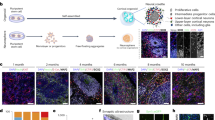Abstract
Neural stem cells (NSCs) can be cultured in two modes of suspension and monolayer in vitro. The cultured cells are different in both the ability to proliferate and heterogeneity. In order to find the appropriate methods for large-scale expansion of NSCs, we systematically compared the NSCs cultured in suspension with those cultured in monolayer. The forebrain tissue was removed from embryonic day 14 (E14) mice, then the tissue was dissociated into single-cell suspension by Accutase and mechanical trituration. The cells were cultured in both suspension and monolayer. The NSCs cultured in suspension and in monolayer were compared on viability, ability to proliferate and heterogeneity by fluorescent dyes, immunofluorescence and flow cytometry on DIV21 (21 days in vitro), DIV56 and DIV112, respectively. The results indicated that the NSCs cultured in both suspension and monolayer represented good viability in long-term cultures. But they displayed a distinct ability to proliferate in long-term cultures. The NSCs cultured in monolayer preceded those cultured in suspension on the ability to proliferate on DIV21 and DIV56, but no obvious difference on DIV112. The NSCs population cultured in suspension displayed more nestin-positive cells than those in monolayer during the whole process of culture. The NSCs population cultured in monolayer, however, displayed more βIII tubulin-positive cells than those in suspension in the same period. The suspension culture mode excels the monolayer culture mode for large-scale expansion of NSCs.









Similar content being viewed by others
References
Bez A, Corsini E, Curti D, Biggiogera M, Colombo A, Nicosia RF, Pagano SF, Parati EA (2003) Neurosphere and neurosphere-forming cells: morphological and ultrastructural characterization. Brain Res 993:18–29
Cai J, Wu Y, Mirua T, Pierce JL, Lucero MT (2002) Properties of a fetal multipotent neural stem cell (NEP Cell). Dev Biol 251:221–240
Gritti A, Parati EA, Cova L, Frolichsthal P, Galli R (1996) Multipotential stem cells from the adult mouse brain proliferate and self-renew in response to basic fibroblast growth factor. J Neurosci 163:1091–1110
Johansson CB, Momma S, Clarke DL, Risiling M, Lendahl U, Frisen J (1999) Identification of a neural stem cell in the adult mammalian central nervous system. Cell 96:25–34
Kanemura Y, Mori H, Kobayashi S, Islam O, Kodama E (2002) Evaluation of in vitro proliferative activity of human fetal neural stem/progenitor cell using indirect measurements of viable cells based on cellular metabolic activity. J Neurosci Res 69:869–879
Ma C, He X, Wilkie N (2001) Growth factors regulate the survival and fate of cells derived from human neurospheres. Nat Biotechnol 19:475–479
Mclarren FH, Svendsen CN, Meide PV, Joiy E (2001) Analysis of neural stem cells by flow cytometry: cellular differentiation modifies patterns of MHC expression. J Neuroimmunol 112:35–46
Milosevic J, Storch A, Schwarz J (2004) Spontaneous apoptosis in murine free-floating neurospheres. Exp Cell Res 294:9–17
Ostenfeld T, Svendsen CN (2004) Requirement for neurogenesis to proceed through the division of neuronal progenitors following differentiation of epidermal growth factor and fibroblast growth factor-2-responsive human neural stem cells. Stem Cells 22:798–811
Ostenfeld T, Caldwell MA, Prowes KR (2000) Human neural precursor cells express low levels of telomerase in vitro and show diminishing cell proliferation with extensive axonal outgrowth following transplantation. Exp Neurol 164:215–226
Ray J, Gage FH (1999) Neural stem cell isolation, characterization and transplantation. In: Wind U, Jahansson H (eds) Modern techniques in neuroscience research. Springer, Berlin Heidelberg New York, pp 340–359
Ray J, Peterson DA, Schinstine M, Gage FH (1993) Proliferation, differentiation, and long-term culture of primary hippocampal neurons. Proc Natl Acad Sci USA 90:3602–3606
Reynolds BA, Weiss S (1996) Clonal and population analyses demonstrate that an EGF-responsive mammalian embryonic CNS precursor is a stem cell. Dev Biol 175:1–13
Svendsen CN, Borg MG, Armstrong RJE, Rosser AE, Chandran S, Ostenfeld T, Caldwell MA (1998) A new method for the rapid and long-term growth of human neural precursor cells. J Neurosci Methods 85:141–152
Zhao N (2004) The modification of the protocols of the in vitro culture of neural stem cells. M.S. thesis, Dalian University of Technology
Acknowledgment
This work was supported by the Natural Science Foundation of China.
Author information
Authors and Affiliations
Corresponding author
Rights and permissions
About this article
Cite this article
Zheng, K., Liu, TQ., Dai, MS. et al. Comparison of different culture modes for long-term expansion of neural stem cells. Cytotechnology 52, 209–218 (2006). https://doi.org/10.1007/s10616-006-9037-0
Received:
Accepted:
Published:
Issue Date:
DOI: https://doi.org/10.1007/s10616-006-9037-0




